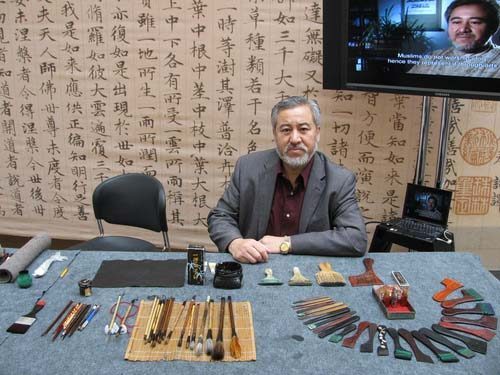
By Omar Mohamed
Speeding through the sun-soaked streets or dawdling through Doha’s many malls, residents might notice that “Ramadan Kareem” has become a greeting synonymous with iftar buffets and chocolate advertisements.
For those who aren’t in the mood to buy or feast on anything this month, Qatar has something else to offer – a healthy helping of culture.
Throughout Ramadan, Katara Cultural Village is hosting a range of free events and exhibitions for all ages.
Here are five of our favorites:
1) Exhibitions. These galleries focused on Arab-Islamic art have already opened to the viewing public.

- Arabic Calligraphy and the Quran, a shared journey (Building 22, Gallery 1 & 2): Depicts how calligraphy helped develop the aesthetics of the Quran and the subsequent impact on Islamic society. The exhibition is comprised predominantly of early copies of the Quran, but also includes other notable works;
- 99 Names of Allah (Building 19, Gallery 1): Showcases the work of graffiti artist/calligrapher Vincent Abadie Hafez (Zepha) and his 99 silk screen paintings, each representing one of the names of Allah, as well as eight large-scale paintings. Here, visitors can try their own hand at graffiti through an “expression wall.”

- Oneness (Building 18): Also pays tribute to the 99 names of Allah. Shahida Ahmed’s exhibition comprises of 99 cubes, each with a name of Allah written in a Kufic typography. The geometric symmetry of cubes is rooted in Islamic artistic traditions.
- Show of Faith (Building 18, Gallery 2): Celebrates the holy month of Ramadan through the art of Ayman Yossri, Basmah Felemban, Ibrahim Abumsmar and Musaed Al-Hulis. It looks between the lines, highlighting the permeations of iconographic practices from the heart of Islam across cultural borders. Includes: The Sleep of the Wicked: Highly-rated Al-Hulis’ exhibition is described as “a dark caution against corruption and immorality.” The display itself is anything but dark, with a familiar Arabesque form hollowed out and garishly covered in floral motifs. And Jeem: Felemban’s exhibit, which was also on display in the London National Gallery’s Hajj exhibition in 2012, is not dissimilar to Shahida Ahmed’s work in conception. The maze-like Jeem seeks to “reveal a deeper mystical contemplation of the hidden aspects of the religion” and also utilises the Kufic typeface to juxtapose her abstractions of “jannah” (heaven) and “jeem” (hell).
2) Performances
For the rest of Ramadan, Sabah Arbilli will be conducting a live-painting performance called Metaphoric in Building 19, Gallery 2. The artist, who has been commissioned by Fanar to recreate extracts from the Quran, will produce a series of 21 pieces live in the gallery.

Visitors are encouraged to watch the award-winning artist as he creates these pieces, which aim to “capture the theme of Ramadan using letters and words which unravel a message and meaning.”
3) Documentaries
In addition to the numerous art exhibitions, a series of calligraphy-centered documentaries are also being presented. There are three documentaries left, and they will be screened in the Katara Drama Theatre (Building 16), at 10pm on July 29, 30, and 31.

The distinguished Arab-Chinese calligrapher, Haji Noor Deen’s Fingerprints is one to watch.
4) Sand Animation
Katara will also host a sand animation show on July 19 and 20. Sand animation is where an artist, in this case the “unique” Shaima Al-Muhairi, uses sand to communicate a scene or story which is then projected onto a screen behind where they are working.
The use of sand as an artistic medium has become immensely popular, especially since a video of Kseniya Simonova, winner of Ukraine’s Got Talent in 2009, performing a sand animation went viral on YouTube. Coming from a region where cities seem to have risen from the sand, it would not be surprising to find a certain natural intuitiveness driving Al-Muhairi performances.
5) Help make a Guinness World Record: Million Dots
In his second interactive piece, Sabah Arbilli, the British-Iraqi artist behind Metaphoric, is co-producing Million Dots in the courtyard by Katara’s main masjid, near Katara Art Studios in Building 19. Visitors are invited to add “dots” to a 7-meter long canvas in this quasi-educational artistic venture.
The inspiration that underpins “Million Dots,” is that, unlike in modern calligraphy, dots were traditionally omitted from the Arabic artistic expression. In addition, participants of Million Dots will be entered into a prize draw with the chance of winning one of Arbilli’s paintings.
Read the full list of Katara’s activities below:
Thoughts?
Credit: Photos of Katara by Omar Chatriwala, photo of Haji Noor Deen by Asian Art Museum.







